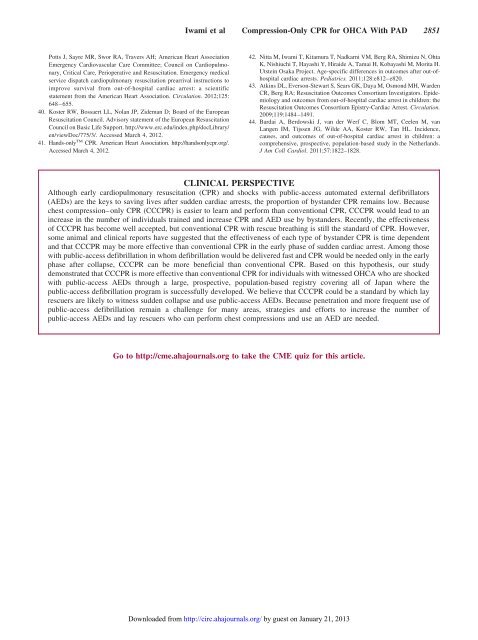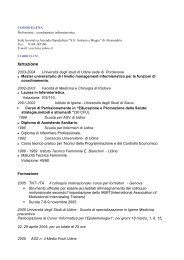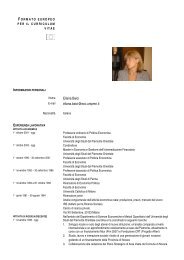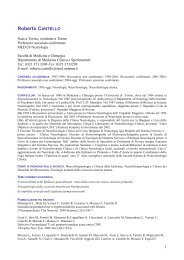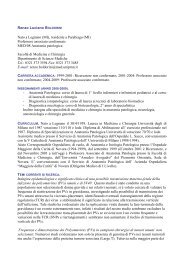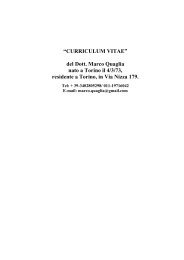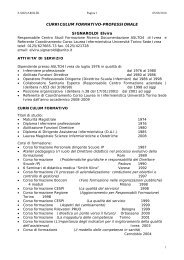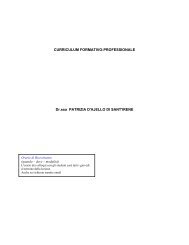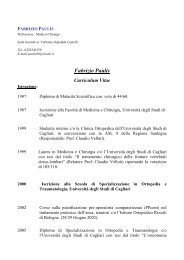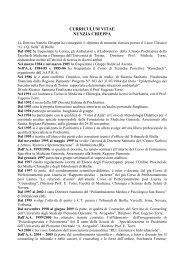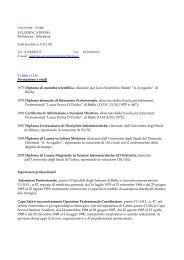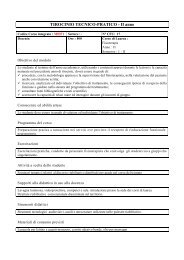2850 <strong>Circulation</strong> December 11, 2012Regional variation in out-of-hospital cardiac arrest incidence andoutcome. JAMA. 2008;300:1423–1431.9. Hollenberg J, Herlitz J, Lindqvist J, Riva G, Bohm K, Rosenqvist M,Svensson L. Improved survival after out-of-hospital cardiac arrest isassociated with an increase in proportion of emergency crew–witnessedcases and bystander cardiopulmonary resuscitation. <strong>Circulation</strong>. 2008;118:389–396.10. Berg RA, Sanders AB, Kern KB, Hilwig RW, Heidenreich JW, PorterME, Ewy GA. Adverse hemodynamic effects of interrupting chest compressions<strong>for</strong> rescue breathing during cardiopulmonary resuscitation <strong>for</strong>ventricular fibrillation cardiac arrest. <strong>Circulation</strong>. 2001;104:2465–2470.11. Ewy GA, Zuercher M, Hilwig RW, Sanders AB, Berg RA, Otto CW,Hayes MM, Kern KB. Improved neurological outcome with continuouschest compressions compared with 30:2 compressions-to-ventilations cardiopulmonaryresuscitation in a realistic swine model of out-of-hospitalcardiac arrest. <strong>Circulation</strong>. 2007;116:2525–2530.12. Iwami T, Kawamura T, Hiraide A, Berg RA, Hayashi Y, Nishiuchi T,Kajino K, Yonemoto N, Yukioka H, Sugimoto H, Kakuchi H, Sase K,Yokoyama H, Nonogi H. Effectiveness of bystander-initiatedcardiac-only resuscitation <strong>for</strong> patients with out-of-hospital cardiac arrest.<strong>Circulation</strong>. 2007;116:2900–2907.13. SOS-KANTO <strong>Study</strong> Group. Cardiopulmonary resuscitation bybystanders with chest compression only (SOS-KANTO): an observationstudy. Lancet. 2007;369:920–926.14. Bohm K, Rosenqvist M, Herlitz J, Hollenberg J, Svensson L. Survival issimilar after standard treatment and chest compression only in out-ofhospitalbystander cardiopulmonary resuscitation. <strong>Circulation</strong>. 2007;116:2908–2912.15. Bobrow BJ, Spaite DW, Berg RA, Stolz U, Sanders AB, Kern KB,Vadeboncoeur TF, Clark LL, Gallagher JV, Stapczynski JS, LoVecchioF, Mullins TJ, Humble WO, Ewy GA. Chest compression-only CPR bylay rescuers and survival from out-of-hospital cardiac arrest. JAMA.2010;304:1447–1454.16. Kitamura T, Iwami T, Kawamura T, Nagao K, Tanaka H, Berg RA,Hiraide A; Implementation Working Group <strong>for</strong> All-Japan UtsteinRegistry of <strong>the</strong> Fire and Disaster Management Agency. Time-dependenteffectiveness of chest compression-only and conventional cardiopulmonaryresuscitation <strong>for</strong> out-of-hospital cardiac arrest of cardiac origin.<strong>Resuscitation</strong>. 2011;82:3–9.17. Kitamura T, Iwami T, Kawamura T, Tanaka H, Nagao K, Nadkarni VM,Berg RA, Hiraide A; Implementation Working Group <strong>for</strong> All-JapanUtstein Registry of <strong>the</strong> Fire and Disaster Management Agency. Conventionaland chest-compression-only cardiopulmonary resuscitation bybystanders <strong>for</strong> children who have out-of-hospital cardiac arrests: a prospective,nationwide, population-based cohort study. Lancet. 2010;375:1347–1354.18. Kitamura T, Iwami T, Kawamura T, Nagao K, Tanaka H, Hiraide A;Implementation Working Group <strong>for</strong> All-Japan Utstein Registry of <strong>the</strong> Fireand Disaster Management Agency. Bystander-initiated rescue breathing<strong>for</strong> out-of-hospital cardiac arrests of noncardiac origin. <strong>Circulation</strong>. 2010;122:293–299.19. Ogawa T, Akahane M, Koike S, Tanabe S, Mizoguchi T, Imamura T.Outcomes of chest compression only CPR versus conventional CPRconducted by lay people in patients with out of hospital cardiopulmonaryarrest witnessed by bystanders: nationwide population based observationalstudy. BMJ. 2011;342:c7106.20. Kitamura T, Iwami T, Kawamura T, Nagao K, Tanaka H, Hiraide A;Implementation Working Group <strong>for</strong> All-Japan Utstein Registry of <strong>the</strong> Fireand Disaster Management Agency. Nationwide public access defibrillationin Japan. N Engl J Med. 2010;362:994–1004.21. Berdowski J, Blom MT, Bardai A, Tan HL, Tijssen JG, Koster RW.Impact of onsite or dispatched automated external defibrillator use onsurvival after out-of-hospital cardiac arrest. <strong>Circulation</strong>. 2011;124:2225–2232.22. Weisfeldt ML, Sitlani CM, Ornato JP, Rea T, Aufderheide TP, Davis D,Dreyer J, Hess EP, Jui J, Maloney J, Sopko G, Powell J, Nichol G,Morrison LJ; ROC Investigators. Survival after application of automaticexternal defibrillators be<strong>for</strong>e arrival of <strong>the</strong> emergency medical system:evaluation in <strong>the</strong> resuscitation outcomes consortium population of 21million. J Am Coll Cardiol. 2010;55:1713–1720.23. Larsen MP, Eisenberg MS, Cummins RO, Hallstrom AP. Predictingsurvival from out-of-hospital cardiac arrest: a graphic model. Ann EmergMed. 1993;22:1652–1658.24. Valenzuela TD, Roe DJ, Cretin S, Spaite DW, Larsen MP. Estimatingeffectiveness of cardiac arrest interventions: a logistic regression survivalmodel. <strong>Circulation</strong>. 1997;96:3308–3313.25. Swor RA, Boji B, Cynar M, Sadler E, Basse E, Dalbec DL, Grubb W,Jacobson R, Jackson RE, Maher A. Bystander vs EMS first-responderCPR: initial rhythm and outcome in witnessed nonmonitored out-ofhospitalcardiac arrest. Acad Emerg Med. 1995;2:494–498.26. Dorph E, Wik L, Strømme TA, Eriksen M, Steen PA. Oxygen deliveryand return of spontaneous circulation with ventilation:compression ratio2:30 versus chest compressions only CPR in pigs. <strong>Resuscitation</strong>. 2004;60:309–318.27. Sayre MR, Berg RA, Cave DM, Page RL, Potts J, White RD; AmericanHeart Association Emergency Cardiovascular Care Committee.Hands-only (compression-only) cardiopulmonary resuscitation: a call toaction <strong>for</strong> bystander response to adults who experience out-of-hospitalsudden cardiac arrest: a science advisory <strong>for</strong> <strong>the</strong> public from <strong>the</strong>American Heart Association Emergency Cardiovascular Care Committee.<strong>Circulation</strong>. 2008;117:2162–2167.28. Cummins RO, Chamberlain DA, Abramson NS, Allen M, Baskett P,Becker L, Bossaert L, Delooz H, Dick W, Eisenberg M, Evans TR,Holmberg S, Kerber R, Mullie A, Ornato JP, Sandoe E, Skulberg E,Tunstall-Pedoe H, Swanson R, Thies WH. Recommended guideline <strong>for</strong>uni<strong>for</strong>m reporting of data from out-of-hospital cardiac arrest: <strong>the</strong> Utsteinstyle: a statement <strong>for</strong> health professionals from a task <strong>for</strong>ce of <strong>the</strong>American Heart Association, <strong>the</strong> European <strong>Resuscitation</strong> Council, <strong>the</strong>Heart and Stroke Foundation of Canada, and <strong>the</strong> Australian <strong>Resuscitation</strong>Council. <strong>Circulation</strong>. 1991;84:960–975.29. Jacobs I, Nadkarni V, Bahr J, Berg RA, Billi JE, Bossaert L, Cassan P,Coovadia A, D’Este K, Finn J, Halperin H, Handley A, Herlitz J, HickeyR, Idris A, Kloeck W, Larkin GL, Mancini ME, Mason P, Mears G,Monsieurs K, Montgomery W, Morley P, Nichol G, Nolan J, Okada K,Perlman J, Shuster M, Steen PA, Sterz F, Tibballs J, Timerman S, TruittT, Zideman D. Cardiac arrest and cardiopulmonary resuscitation outcomereports: update and simplification of <strong>the</strong> Utstein templates <strong>for</strong> resuscitationregistries: a statement <strong>for</strong> healthcare professionals from a task <strong>for</strong>ceof <strong>the</strong> International Liaison Committee on <strong>Resuscitation</strong> (American HeartAssociation, European <strong>Resuscitation</strong> Council, Australian <strong>Resuscitation</strong>Council, New Zealand <strong>Resuscitation</strong> Council, Heart and Stroke Foundationof Canada, InterAmerican Heart Foundation, <strong>Resuscitation</strong>Councils of Sou<strong>the</strong>rn Africa). <strong>Circulation</strong>. 2004;110:3385–3397.30. Effect of first aid <strong>for</strong> cardiopulmonary arrest [in <strong>Japanese</strong>]. AmbulanceService Planning Office of Fire and Disaster Management Agency of Japan.http://www.fdma.go.jp/neuter/topics/houdou/h23/2312/231216_1houdou/02_1.pdf. Accessed January 2, 2012.31. <strong>Japanese</strong> Guidelines <strong>for</strong> Emergency Care and Cardiopulmonary <strong>Resuscitation</strong>.3rd ed. Tokyo, Japan: Health Shuppansha; 2007.32. Report on a study on social system development to improve survival fromemergency cardiovascular disease using automated external defibrillator(Marukawa’s report) [in <strong>Japanese</strong>]. http://kouroukaken-kyukyusosei.info/. Accessed March 4, 2012.33. Hallstrom AP, Ornato JP, Weisfeldt M, Travers A, Christenson J,McBurnie MA, Zalenski R, Becker LB, Schron EB, Proschan M; PublicAccess Defibrillation Trial Investigators. Public-access defibrillation andsurvival after out-of-hospital cardiac arrest. N Engl J Med. 2004;351:637–646.34. Sanders AB, Kern KB, Atlas M, Bragg S, Ewy GA. Importance of <strong>the</strong>duration of inadequate coronary perfusion pressure on resuscitation fromcardiac arrest. J Am Coll Cardiol. 1985;6:113–118.35. Bobrow BJ, Clark LL, Ewy GA, Chikani V, Sanders AB, Berg RA,Richman PB, Kern KB. Minimally interrupted cardiac resuscitation byemergency medical services <strong>for</strong> out-of-hospital cardiac arrest. JAMA.2008;299:1158–1165.36. Kellum MJ, Kennedy KW, Barney R, Keilhauer FA, Bellino M, ZuercherM, Ewy GA. Cardiocerebral resuscitation improves neurologically intactsurvival of patients with out-of-hospital cardiac arrest. Ann Emerg Med.2008;52:244–252.37. Aufderheide TP, Sigurdsson G, Pirrallo RG, Yannopoulos D, McKnite S,von Briesen C, Sparks CW, Conrad CJ, Provo TA, Lurie KG.Hyperventilation-induced hypotension during cardiopulmonary resuscitation.<strong>Circulation</strong>. 2004;109:1960–1965.38. Hüpfl M, Selig HF, Nagele P. Chest-compression-only versus standardcardiopulmonary resuscitation: a meta-analysis. Lancet. 2010;376:1552–1557.39. Lerner EB, Rea TD, Bobrow BJ, Acker JE 3rd, Berg RA, Brooks SC,Cone DC, Gay M, Gent LM, Mears G, Nadkarni VM, O’Connor RE,Downloaded from http://circ.ahajournals.org/ by guest on January 21, 2013
Iwami et al Compression-Only CPR <strong>for</strong> OHCA With PAD 2851Potts J, Sayre MR, Swor RA, Travers AH; American Heart AssociationEmergency Cardiovascular Care Committee; Council on Cardiopulmonary,Critical Care, Perioperative and <strong>Resuscitation</strong>. Emergency medicalservice dispatch cardiopulmonary resuscitation prearrival instructions toimprove survival from out-of-hospital cardiac arrest: a scientificstatement from <strong>the</strong> American Heart Association. <strong>Circulation</strong>. 2012;125:648–655.40. Koster RW, Bossaert LL, Nolan JP, Zideman D; Board of <strong>the</strong> European<strong>Resuscitation</strong> Council. Advisory statement of <strong>the</strong> European <strong>Resuscitation</strong>Council on Basic Life Support. http://www.erc.edu/index.php/docLibrary/en/viewDoc/775/3/. Accessed March 4, 2012.41. Hands-only TM CPR. American Heart Association. http://handsonlycpr.org/.Accessed March 4, 2012.42. Nitta M, Iwami T, Kitamura T, Nadkarni VM, Berg RA, Shimizu N, OhtaK, Nishiuchi T, Hayashi Y, Hiraide A, Tamai H, Kobayashi M, Morita H.Utstein Osaka Project. Age-specific differences in outcomes after out-ofhospitalcardiac arrests. Pediatrics. 2011;128:e812–e820.43. Atkins DL, Everson-Stewart S, Sears GK, Daya M, Osmond MH, WardenCR, Berg RA; <strong>Resuscitation</strong> Outcomes Consortium Investigators. Epidemiologyand outcomes from out-of-hospital cardiac arrest in children: <strong>the</strong><strong>Resuscitation</strong> Outcomes Consortium Epistry-Cardiac Arrest. <strong>Circulation</strong>.2009;119:1484–1491.44. Bardai A, Berdowski J, van der Werf C, Blom MT, Ceelen M, vanLangen IM, Tijssen JG, Wilde AA, Koster RW, Tan HL. Incidence,causes, and outcomes of out-of-hospital cardiac arrest in children: acomprehensive, prospective, population-based study in <strong>the</strong> Ne<strong>the</strong>rlands.J Am Coll Cardiol. 2011;57:1822–1828.CLINICAL PERSPECTIVEAlthough early cardiopulmonary resuscitation (CPR) and shocks with public-access automated external defibrillators(AEDs) are <strong>the</strong> keys to saving lives after sudden cardiac arrests, <strong>the</strong> proportion of bystander CPR remains low. Becausechest compression–only CPR (CCCPR) is easier to learn and per<strong>for</strong>m than conventional CPR, CCCPR would lead to anincrease in <strong>the</strong> number of individuals trained and increase CPR and AED use by bystanders. Recently, <strong>the</strong> effectivenessof CCCPR has become well accepted, but conventional CPR with rescue breathing is still <strong>the</strong> standard of CPR. However,some animal and clinical reports have suggested that <strong>the</strong> effectiveness of each type of bystander CPR is time dependentand that CCCPR may be more effective than conventional CPR in <strong>the</strong> early phase of sudden cardiac arrest. Among thosewith public-access defibrillation in whom defibrillation would be delivered fast and CPR would be needed only in <strong>the</strong> earlyphase after collapse, CCCPR can be more beneficial than conventional CPR. Based on this hypo<strong>the</strong>sis, our studydemonstrated that CCCPR is more effective than conventional CPR <strong>for</strong> individuals with witnessed OHCA who are shockedwith public-access AEDs through a large, prospective, population-based registry covering all of Japan where <strong>the</strong>public-access defibrillation program is successfully developed. We believe that CCCPR could be a standard by which layrescuers are likely to witness sudden collapse and use public-access AEDs. Because penetration and more frequent use ofpublic-access defibrillation remain a challenge <strong>for</strong> many areas, strategies and ef<strong>for</strong>ts to increase <strong>the</strong> number ofpublic-access AEDs and lay rescuers who can per<strong>for</strong>m chest compressions and use an AED are needed.Go to http://cme.ahajournals.org to take <strong>the</strong> CME quiz <strong>for</strong> this article.Downloaded from http://circ.ahajournals.org/ by guest on January 21, 2013


